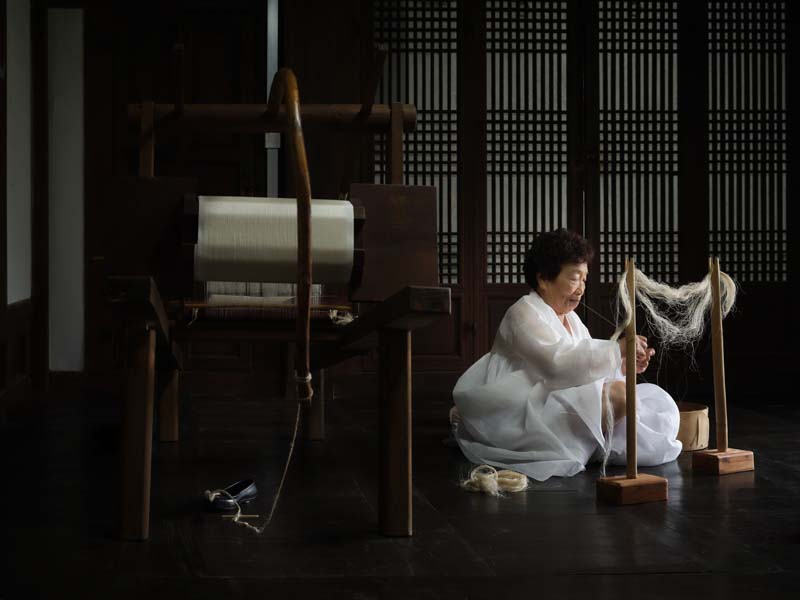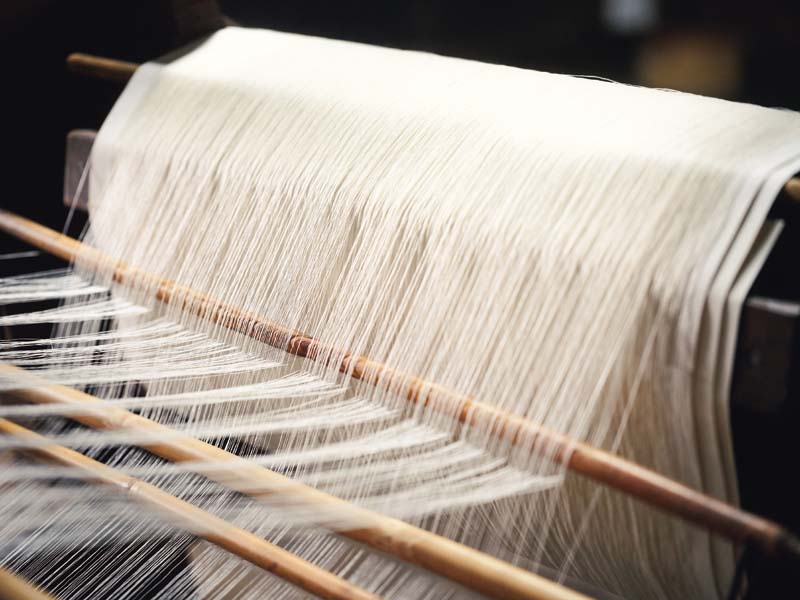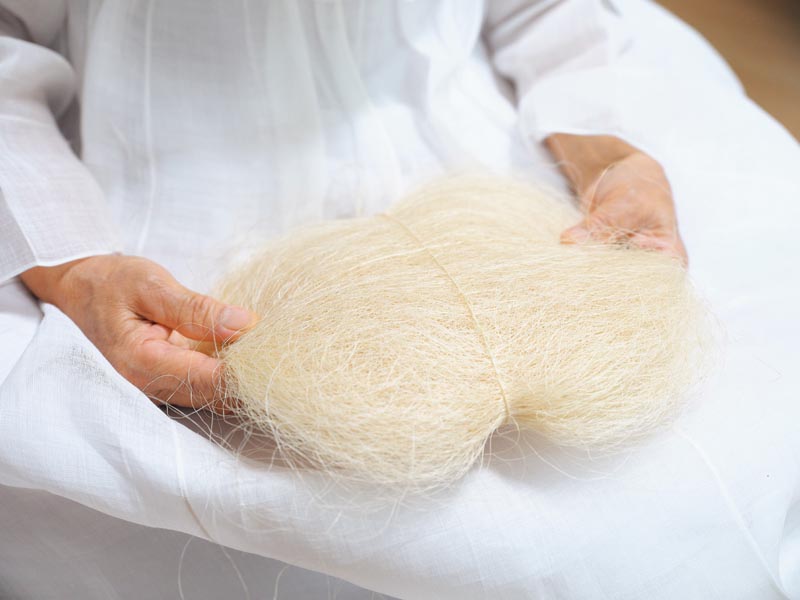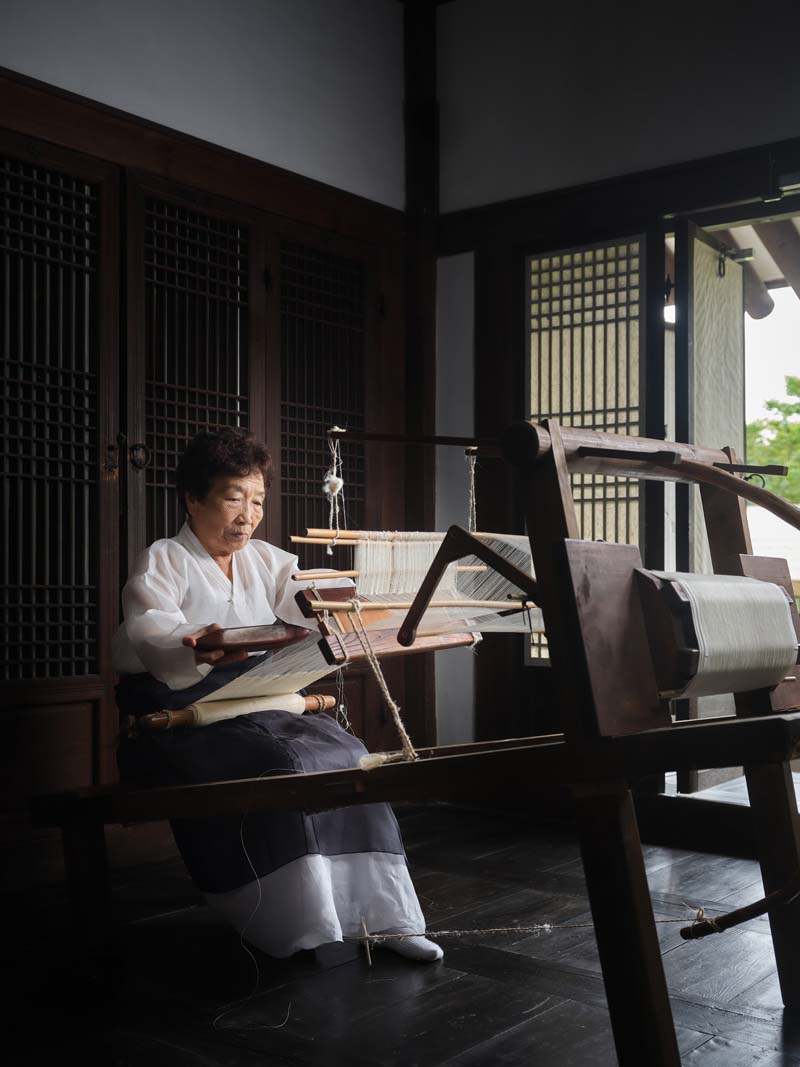Bordered by the West Sea and the Geum River, the Hansan region’s humid climate and fertile soil provide ideal conditions for cultivating high-quality ramie. During the Joseon Dynasty (1392–1910), Hansan ramie earned nationwide renown as a regional specialty and remains synonymous with ramie fabric to this day. In 1967, the art of weaving Hansan ramie was designated a National Intangible Cultural Heritage, and in 2000, Master Bang Yeon-ok was recognized as the official skill holder. She continues the tradition alongside other local women.

Master Bang Yeon-ok hangs up ramie fibers, which she finely splits with her teeth. She draws out each strand and splices them into long threads by rubbing them on her knees with her palms.
Ramie (mosi), a fabric woven from threads spun from the inner fibers of ramie stems, was traditionally used for Korean summer garments. Among production regions, Hansan in Seocheon County, South Chungcheong Province, has long been renowned for making the finest ramie — Hansan mosi. The craft historically relied on family-based division of labor and village-level collaboration, which boosted productivity and strengthened communal ties. In recognition of its value as a traditional craft transmitted within communities, Hansan ramie weaving was inscribed on UNESCO’s Representative List of the Intangible Cultural Heritage of Humanity in 2011.
Ramie is a natural, hypoallergenic fiber. Even when damp with human sweat, it neither sags nor clings to the skin, and once aired, it quickly regains its crispness, staying fresh even after days of wear. Its cooling feel is unmatched by any other fabric. Well-worn garments look new again after washing and starching, and whether slightly rumpled or patched, ramie retains its distinctive elegance. In the sweltering heat of midsummer, those dressed in ramie exude a quiet, effortless grace.
PREMIUM FABRIC
Ramie was historically prized as fabric for fine clothing, not daily workwear. It found its traditional applications in ceremonial and mourning attire and also served as a royal court tribute and precious trade commodity. Although the exact origins of ramie garments are unclear, records show that the cloth was exported to Tang China during the reign of King Gyeongmun of Unified Silla (r. 861–875), attesting to its long history. In Goryeo dogyeong (Illustrated Account of Goryeo), written by the Song Dynasty envoy Xu Jing after a month-long stay in Goryeo (918–1392) in 1123, he observes, “The weaving technique is so refined that people of all ranks, from king to commoner, wear white ramie clothes.” This suggests that ramie weaving techniques had already reached a high level of sophistication and made fine ramie cloth widely available.
In the late Joseon period, when ramie supply failed to meet demand, prices soared and counterfeit goods circulated, leading the government at one point to temporarily ban ramie production altogether. Historical records indicate that, while the cloth was once produced throughout Chungcheong Province, by the late Joseon period the Hansan area remained the only center of ramie weaving.
SENSITIVITY AND PATIENCE
For farming families across the Hansan area, ramie production was once the most important source of supplementary income. When not tending their fields, women devoted themselves to ramie work. Weaving on the loom was done individually in each household, but the laborious process of turning dried ramie stalks into thread was typically communal, reinforcing social bonds through shared labor.

Ramie threads set on the loom. Hansan ramie is prized for its even, uniform texture, giving it a more refined appearance than ramie from other regions.
Ramie, a perennial nettle, is harvested three times per year — in June, August, and October. While early yields produce weaker fiber, late yields produce coarse material, making the August harvest the most valued. Once the bark is peeled from the stalks, the green inner flesh appears. This core is soaked in water and dried in the sun, a process repeated three or four times, leaving only the white fiber known as taemosi. The fiber is then evenly split into fine strands using the teeth, with thickness judged by the touch of one’s tongue and lips.
“Splitting taemosi can’t be done by machine because it requires trained tactile skill,” explains Master Bang Yeon-ok. “Beginners often split their lips, sometimes until they bleed. Since we moisten the fibers with saliva, people with dry mouths find it particularly difficult. Everyone’s teeth and tongue vary in structure and sensitivity, so each person naturally produces thread with a slightly different thickness.”
The taemosi strands are sorted into three grades — fine, medium, and coarse — then spliced into continuous thread by twisting them between the palms. Next, the warp threads are measured to determine how many will be used for one pok (width of a bolt; about 30 cm for Hansan ramie), depending on their thickness. The denser the warp, the finer the resulting fabric. Warp is counted in units of sae, with one sae equaling eighty threads. Ramie typically ranges from seven to fifteen sae, with anything above ten considered fine ramie, called semosi. For example, ten-sae fabric has eight hundred warp threads. Higher counts indicate finer cloth with greater commercial value.
“Fifteen-sae ramie is finer than silk — it’s like dragonfly wings,” Bang notes. “Weaving it requires an exceptionally fine reed [badi], but since the last master reed-maker passed away in 2006, they have become impossible to obtain. Metal reeds on modern looms simply cannot achieve the same quality.”

A single bundle of ramie fibers is called a gut, and roughly ten such bundles are needed to weave a bolt of ramie cloth.
Once the warp threads are drawn through the loom’s reed, soybean starch is carefully applied to smooth them. At this stage, the slightest error can cause the threads to tangle or snap, a challenge even for someone as experienced as Bang. Once the threads are properly prepared, the loom is assembled for weaving. A single bolt of ten-sae ramie — typically 30 cm by 21.6 m — takes about 15 days to complete. complete. This is enough for a woman’s hanbok skirt and jacket and a man’s upper garment. The finished cloth is washed to remove the starch before it is dried and stored.
“Ramie thread snaps easily when dry. That’s why we weave in sweltering heat with the doors shut tight, working drenched in sweat. These days, humidifiers make it easier to maintain proper moisture levels, so the work is less arduous.”
Although every stage of ramie production demands precision and skill, the final weaving is especially grueling, as the finest cloth must be worked in the suffocating humidity of midsummer. This exquisite fabric is thus born from the fingertips of weavers who endure such punishing conditions.
BLOOD, SWEAT & TEARS — AND SALIVA
Born in 1945, Bang still works with a nimbleness that belies her age.
“My mother first brought me to her loom when I was still nursing. When I grew old enough to start learning to weave, she discouraged me, saying the work was too hard. I was the youngest of eight children, and she wanted to spare me from this difficult life.”
What she had learned by watching her mother became formal training after marriage. In the neighboring village lived the master weaver Mun Jeong-ok (1928–2016), who had been designated the first official skill holder when Hansan ramie weaving was recognized as a National Intangible Cultural Heritage in 1967.
“It must have been fate. I had no idea who she was, but whenever I passed by, I’d watch her working with ramie in the yard and sometimes lend a hand,” Bang reflects.
Recognizing Bang’s skill and personal character, Master Mun encouraged her to train formally. Bang became an official successor of the craft in 1980 and a certified trainee six years later.
“Splitting and joining taemosi came naturally to me, since I’d done it from childhood. But starching warp threads and the actual weaving — that was incredibly challenging. Master Mun often scolded me.”
In 2000, Bang was designated the second official skill holder for Hansan ramie weaving. While others could match her technical skill, many regarded the work as sheer drudgery. What distinguished Bang and led to her succession of Mun was not only her expertise but her genuine passion for the art.
“We weavers have a saying: ‘Weaving ramie takes blood, sweat, saliva, and tears.’ That’s how demanding the work is. Yet when you see the finished fabric, there’s a profound sense of accomplishment. That satisfaction is what drives us to keep teaching and passing down this tradition.”
Now in her eighties, Master Bang continues to work alongside other artisans. She beams as she notes that both her daughter and daughter-in-law have become certified trainees, ensuring that the craft of weaving Hansan ramie will endure into the next generation.

Once the preparations are complete, Bang weaves ramie on the loom, which requires exceptional skill. For an experienced weaver, producing a single bolt of cloth takes about three days.